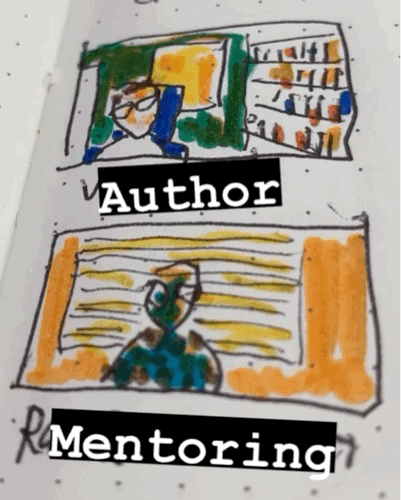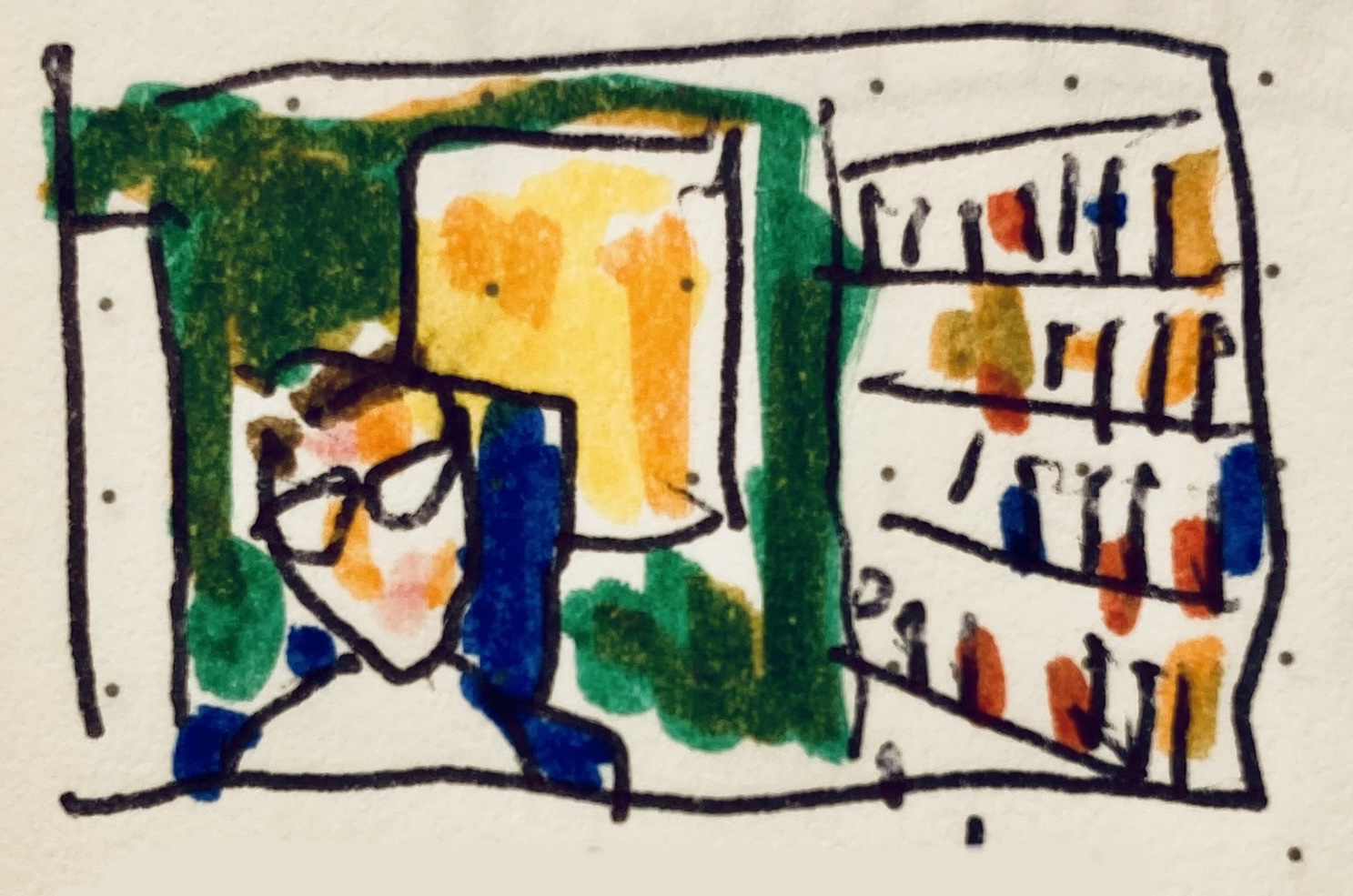These two people were sketched from memory, after I’d had many (separate) Zoom sessions with them:

They’re both authors. The one at the top has completed his manuscript, delivered the whole thing to publishers on both sides of the Atlantic, publishers who seem very happy. (Hurrah!)
The man below is still working on a book proposal, but it’s nearly finished.
With both of these men, I’ve used AI in the writing and editing process.
Specifically, we’ve recorded our conversations – conversations that often meander quite a bit. I don’t encourage the meandering, but I don’t mind it. It’s not a problem because the goal is to capture the author’s unique voice and perspective.
Everyone blithers occasionally, and everyone’s blither is unique.
Once we have the recording, I use AI tools to transcribe it. This saves HOURS of manual transcription and allows us to focus on the content itself.
Ancient History
Working as a journalist, I used to record my interviews with shorthand. I was very fast – if I say so myself, oh yes. I could transcribe almost everything people said, no matter how rapidly they spoke.
Sometimes the interviews went on for an exceedingly long time. Three hours wasn’t common, but it wasn’t uncommon either. My writing hand would feel like booking a holiday in the Seychelles or the Bahamas but, realistically, neither because although the interview had finished, I hadn’t finished.
In order to write it up and file my copy – as we used to call “sending stuff to editors” – I still needed to wade through pages of shorthand to find the bits I needed, often with the clock ticking because I had a short deadline.
Most other journalists used tape recorders, which is all very well but I took a dim view. How do you find the key moments without listening back to absolutely everything? There was no adjustable listening speed, back in Ye Olden Days. And if you didn’t listen to absolutely everything you had to whiz back and forth with the ⏩ and ⏪ buttons, which meant you could easily miss something.
I developed a time-saving approach that is still useful today.
It involved simply writing down EVERYTHING that came to mind as soon as I’d said goodbye to the person I was interviewing.
Didn’t matter about the particular order of the things I wrote down. Just get it on paper, was the general idea, while it’s fresh in the mind. Do it in the loo, a nearby cafe, or a bench – whatever.
After that, I could flick through the more comprehensive shorthand notes and pick out quotes that captured those key points, ignoring the rest.
My goodness, I was fast.
But not as fast as AI
Today, I just press record on the AI I use (currently: Otter.ai) and let it build the transcript while we’re talking.
Otter has a feature that allows me, afterwards, to export the entire conversation as (among other options) a PDF, which I can subsequently interrogate using another tool, Perplexity.ai.
This helps me to structure the transcript into a useful shape. This might involve:
- Identifying key themes and ideas
- Extracting potential chapter topics
- Highlighting compelling anecdotes or case studies
- Summarising main points and arguments
How? I ask the AI simple questions, much as I might ask a human being. I might type, “What did we talk about in this conversation? Write some bullet points please.” Or, “Based on this conversation, what can you tell about ______ (the author I’m working with) that might be useful in the book proposal?
That kind of thing.
Of course, the AI output is just a starting point. The magic happens when I review the structured material with the author.
Together, we refine it further – digging deeper into certain topics, cutting tangents that don’t serve the overall narrative, and rearranging sections for better flow.
Throughout this process, the AI acts as a tireless assistant, helping us quickly sift through the raw conversation and find hot stuff that will make the proposal glow. But it’s the human touch – the author’s unique voice and (I spose) my editorial guidance too – that brings the project to life.
Using AI tools in this way, we can streamline the proposal development without sacrificing creativity or authenticity. The technology helps us work more efficiently.
Who to talk to?
Not everybody reading this has access to someone willing to listen to a lot of blither (or even brilliant, scintillating insights) about a book idea.
And some people reading this may wonder if it’s possible to blither into an AI transcription device alone.
It IS possible. And speaking for myself, I find it quite easy sit in front of my computer, or my phone, blithering into an AI recording device. Typically, I do this with my eyes shut, to remove any distractions. But I can imagine it might be tricky if you haven’t done it before.
So here’s another thing I used to do as a journalist, up against a tight deadline – long before anybody dreamed of using AI.
I drew a simple mind map.
The first one included key topics, and (branching off those) less significant topics.
That first mind map can be done very quickly. It’s not a keeper. The point of the exercise, again, is just to get some words downloaded from your brain onto paper.
The second version is likely to be more helpful because things to do with the structure will have presented themselves in the process of drawing version one. I might then do a third, for the same reason.
These particular mind maps were never intended to be things of beauty. They were just prompts to help me speak with less blither, more focus. I would record myself speaking about the topic as my eye moved around the mind map. Then I would play back the recording and type whatever I had said.
Today, as you “talk your way around a mind map”, the AI creates a transcript almost instantaneously.
***
Case Study
This morning, I went back into my Otter.ai account, and found the first of many conversations with one of the two men pictured above. This one:

Our first conversation took place many months ago. I didn’t listen to the conversation, this morning, just downloaded the transcript, which I then uploaded into Perplexity.ai.
I asked Perplexity to suggest how this particular conversation might provide useful lessons to others thinking about using AI to write a book proposal.
Here’s what it suggested:
- AI can be used to generate a transcript of the conversation, which can then be analysed and used as the basis for the book proposal. The transcript provides a detailed record of the discussion that can be referenced and incorporated into the proposal.
- AI can be used to summarise key points and ideas from the conversation, such as the target audience, unique selling points of the book, and the overall narrative and structure. This can help the authors quickly identify the most important elements to include in the proposal.
- AI can be used to extract specific details and examples from a conversation, such as (in this one) the anecdotes about the financial industry and air traffic controllers, which can be used to illustrate the book’s concepts and make the proposal more compelling.
- AI can be used to analyse the language and tone of the conversation, and then apply that to the writing of the proposal to ensure a consistent and engaging voice.
- AI can be used to identify potential collaborators, such as the neuroscientist mentioned, and incorporate their expertise and perspectives into the proposal.
- AI can be used to generate visuals and graphics, such as the _______ (redacted by JPF) that is described in this conversation, to help illustrate the book’s concepts and make the proposal more visually appealing.
Overall, this conversation demonstrates the many ways that AI can help to streamline the book proposal writing process, from transcription and summary to idea generation and visual design.
Important message to People Of The Future
Everything is changing so fast that attempting to describe current technology is like trying to catch a bullet between the teeth.
To you, O Person Of The Future, what I say here about using AI may appear utterly banal.
“Hey, look what I did using AI!” may sound to you like it would sound to me if someone said, “Hey, look what I wrote – with a pencil!”
In which case, I can only apologise and wish you more success in the painful business of not seeming entirely out of date, all the time. And here, for your delectation, is a drawing of a pencil:

***
Write A Book Proposal
I ran free 45-minute Zooms throughout July. Thursday lunchtimes and early evening. They were open to all, thanks to the support of my patrons.
And they were terrific fun. Alas, they’re now finished.
If you’d like to be part of anything similar in future, sign up for my newsletter and I’ll let you know when the next one happens.